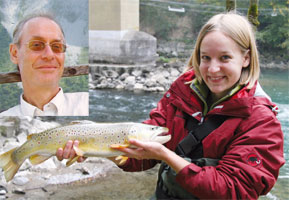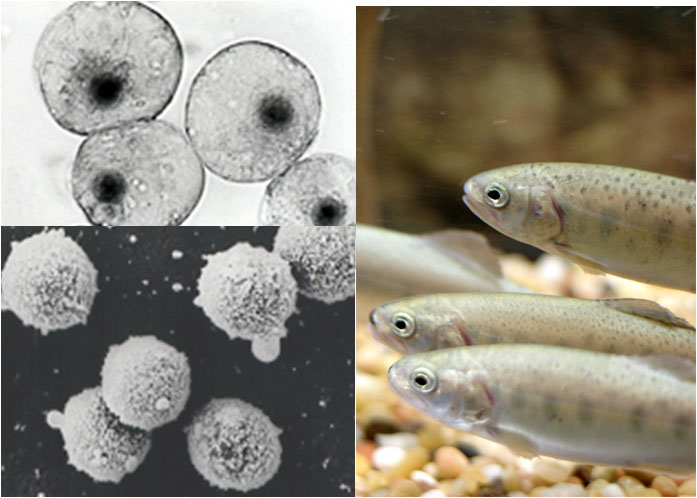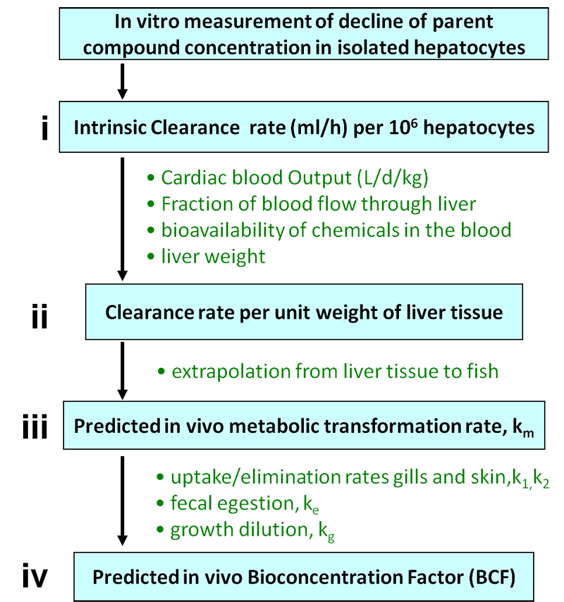 |
de | fr | en Druckansicht ![]()
3R-INFO-BULLETIN 47
October 2011
Authors

Helmut Segner’s research group has been working on the development and application of fish in vitro models in chemical toxicity assessment for many years. He is head of the Centre for Fish and Wildlife Health (FIWI) at the Vetsuisse Faculty of the University of Berne. Catharina Lany characterized the liver cell metabolism assay as part of her doctoral thesis in veterinary medicine at the FIWI. She is now working as a fish veterinarian at a private clinic.
Address:
Helmut Segner
helmut.segner@vetsuisse.unibe.ch
Centre for Fish and Wildlife Health
Vetsuisse Faculty, University of Berne
Länggassstr. 122, Postfach 8466
CH-3001 Bern, Switzerland
Editor
Peter Maier, Scientific Adviser of the 3R Research Foundation
Metabolism as part of alternative testing strategies in fish
This project (No. 108-07) supported by the 3R Research Foundation explored the utility of isolated fish hepatocytes to predict bioconcentration[*], of lipophilic environmental contaminants in fish. The results demonstrate the value of a metabolically competent in vitro system such as isolated liver cells as part of animal-free testing strategies to in vivo assessment of chemical bioconcentration in fish.
Alternatives to chemical bioconcentration testing with fish
Bioconcentration results from the competing rates of chemical uptake via gills and skin (k1) and chemical elimination via respiratory exchange (k2), fecal egestion (ke) and metabolic biotransformation (km) (1). In addition, dilution by growth (kd) can influence bioconcentration. With these different processes being involved, it is clear that non-animal approaches to bioconcentration assessment cannot rely on one single method, but need to be based on an array of methodologies (see reports of HESI Bioaccumulation Committee: 2, 3). A first approximation of the bioconcentration potential of an organic chemical in aquatic organisms can be provided by the hydrophobicity model, which considers bioconcentration as a passive partitioning of chemicals between the water phase and the lipid phase of the organism. Taking octanol as a surrogate for lipid, bioconcentration can then be predicted from the octanol-water partition coefficient, Kow. As an improvement of the hydrophobicity model, the PDMS-PAMPA method (Parallel Artificial Membrane Permeability Assay) (4) provides measured values for the passive diffusion processes governing xenobiotic uptake and elimination via gills and skin (5).
The aforementioned approaches can be used to obtain a reliable estimate of bioconcentration of non-metabolizable chemicals. They are not able to predict bioconcentration of chemicals that undergo biotransformation, however. Metabolically competent in vitro assays therefore have to be included in alternative testing strategies for fish BCF.
In vitro metabolism assay with fish hepatocytes
Hepatocytes are isolated from rainbow trout liver using a two-step-perfusion method (Fig. 1). Fresh suspensions of the isolated cells are then dosed with the test chemical and incubated over a 2-hour-period at physiological temperature (12-16°C). Samples are taken at regular intervals from the incubation medium and processed for chemical analysis. The rate of disappearance of the test compound from the incubation medium over time provides the intrinsic clearance rate (ml/h/106 cells). The 3R project placed much emphasis on optimizing assay conditions with respect to cell density, media composition and bioavailability of the test compound under in vitro conditions.

Fig 1
Light (top) and scanning electron (bottom) micrographs of isolated hepatocytes from rainbow trout.
Prediction in fish via metabolic rates in isolated hepatocytes.
Physiologically based prediction models have to be used to extrapolate from the intrinsic clearance rate measured in the isolated trout hepatocytes to the metabolic rate km of the test chemical in the intact fish (6, 7). These models initially scale from the isolated liver cells to the clearance rate of the whole liver, and then to the metabolic transformation rate km of the whole fish (Fig. 2.). The predicted km value, together with estimates of passive uptake and elimination processes, as derived from the hydrophobicity model and the PDMS-PAMPA method, can then be used to calculate the in vivo bioconcentration factor (BCF) value of the test chemical.

Fig 2
Prediction model to extrapolate from xenobiotic metabolic rates measured in the isolated hepatocytes (i) to the metabolic rates of the whole liver (ii), and then to the metabolic rates of the whole fi sh (iii). The
latter rate is then combined with values of the other processes involved in bioconcentration, including data derived from hydrophobicity models or membrane permeability assays (k1 and k2) to predict a BCF for a particular chemical (iv).
Does the fish liver cells assay come up to expectations?
Table 1 shows examples of predictions of in vivo BCF values for metabolizable xenobiotics from the trout hepatocyte assay. The results illustrate that the hepatocyte assay is able to correct over-predictions of bioconcentration of metabolizable compounds, as generated by the hydrophobicity model: Kow-based BCF predictions would have classified the substances as “bioaccumulative” while with the data from the hepatocyte assay, the substances are classified as “non-bioaccumulative”, which is in line with the results from in vivo bioconcentration testing.
Seasonal changes such as water temperature have a pronounced influence on physiology and metabolic activity of poikilothermic organisms such as fish. Accordingly, metabolic capacities of the isolated fish liver cells showed seasonal variation, with good metabolic rates observed from early summer until autumn, but low metabolic rates during winter. In order to achieve a year-round supply of rainbow trout hepatocytes with comparable metabolic capacity, cryopreservation of isolated trout hepatocytes was investigated. It was found that cells of rainbow trout can be successfully frozen and thawed with metabolic rates being comparable to freshly isolated hepatocytes (8).

Table 1: Influence of in vitro-generated metabolic rate values on the BCF.
Compared to values without assumed metabolism (km = 0, bioconcentration depends on uptake and elimination processes at skin and gills, together with fecal egestion and growth dilution), the BCF is 30 fold (all values in L/kg) for BaP and 4 fold lower for 4 NP respectively, when using km values predicted from hepatocyte in vitro tests. The ranges of predicted BCF values derive from two different models.
Towards acceptance and implementation
This project provides proof of the principle that using fish hepatocytes is a reliable method for correctly predict in vivo metabolic rates and therefore plays an essential role in a non-animal testing strategy for BCF assessment of chemicals. This in vitro strategy largely replaces the need to use living fish, shortens the test period for a given chemical compared to the in vivo test, is cheaper and allows in specific cases the mechanism of toxicity, e.g. the pattern of metabolites, to be investigated. Data obtained within this project will be published soon (8). The next steps that are needed to implement this test in the regulatory praxis are (i) to test a broader range of chemicals in order to learn more about the range of possible applications for the assay, and (ii) to perform inter-laboratory comparisons in order to validate the assay for its regulatory use. Both steps are being taken.
PDF version of this Bulletin No. 47
References:
- Arnot JA, Gobas F (2006) A review of bioconcentration factor (BCF) and bioaccumulation factor (BAF) assessments for organic chemicals in aquatic organisms. Environ Rev 14:257-330
- Nichols JS, Erhardt S, Dyer MJ, Moore M, Plotzke K, Segner H, Schultz I, Thomas K, Vasiluk J, Weisbrod A (2007) Use of in vitro Absorption, Distribution, Metabolism, and Excretion (ADME) data in bioaccumulation assessments for fish. Human and Ecological Risk Assessment 13: 1164-1191.
- Weisbrod AV, Sahi J, Segner H, James MO, Nichols J, Schultz I, Erhardt S, Cowan-Ellsberry C, Bonnell M, Hoeger B (2009). The state of in vitro science for use in bioaccumulation assessments for fish. Environmental Toxicology and Chemistry 28:86-06.
- Kwon, J.-H., Escher, B. I. (2008), "A modified parallel artificial membrane permeability assay for evaluating bioconcentration of highly hydrophobic chemicals in fish", Environ. Sci. Technol., 42, 1787-1793.
- Escher B, Kwon JH.2008. Bioconcentration in fish can be assessed in vitro. 3R Bulletin No. 37.
- Cowan-Ellsberry CS, Dyer S, Erhardt S, Bernhard MJ, Roe A, Dowty M, Weisbrod A (2008) Approach for extrapolating in vitro metabolism data to refine bioconcentration factor estimates. Chemosphere 70: 1804-17.
- Han X, Nabb D, Mingoia R, Yang C (2007) Determination of xenobiotic intrinsic clearance in freshly isolated hepatocytes from rainbow trout (Oncorhynchus mykiss) and rat and its application in bioaccumulation assessment. Environ Sci Technol 41: 3269-76.
- Lany C., Möller AM, Hermsen C, Han X and Segner H. (2012) Optimization and standardization of the fish metabolic competence assay with isolated hepatocytes from rainbow trout (in preparation).
| [*] | Bioaccumulation, bioconcentration, OECD 305 and chemical regulationsTwo terms are usually used to describe the enrichment of environmental chemicals in organisms: i) Bioaccumulation refers to a process in which a chemical is absorbed in an organism by all routes of exposure, including diet and surrounding (respiratory) medium (in the case of fish: water). ii) Bioconcentration refers to the absorption of a chemical from the ambient environment through respiratory and dermal epithelia and does not include dietary uptake. The extent to which chemicals are bioconcentrated is expressed using the bioconcentration factor (BCF). This represents the ratio of the steady-state chemical concentration in the organism to the chemical concentration in the respiratory medium. In most countries, chemical regulations require the assessment of the bioaccumulative potential, estimated from the BCF in fish. The gold standard test to determine the BCF is OECD Test Guideline 305. According to this guideline, fish are exposed to the chemical for 28 days in order to reach an equilibrium of chemical concentration between fish and water, followed by a 28-day depuration period in order to measure the elimination rate. In addition to being lengthy, the test is also costly (approximately 125,000 € per chemical), and uses a high number of animals (minimum: 108 fish/chemical). Under the European Community Regulation REACH on chemicals and their safe use (EC 1907/2006) BCF information is needed for chemicals with a lipophilicity (measured as octanol-water partition coefficient, Kow) of log Kow ≥ 2.7 that are produced at > 100 tons per year. BCF data are required not only for new but also for existing chemicals. For the vast majority of existing compounds BCF data are not available. For instance, in a Canadian chemical management program on 23,000 existing compounds, BCF information was found to exist for less than 4 % of the chemicals (3). To meet BCF data requirements under the established OECD 305 guideline, it would be necessary to substantially increase the number of fish used for testing purposes. REACH see: http://ec.europa.eu/environment/chemicals/reach/reach_intro.htm |
| Letzte Änderung: 21.10.2011 |